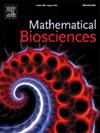基于人口地理数据的两种HIV毒株感染的时空建模和分析。
IF 1.8
4区 数学
Q2 BIOLOGY
引用次数: 0
摘要
耐药性的出现对艾滋病毒/艾滋病的临床治疗构成重大挑战,使耐药菌株在受感染人群中的传播成为监测和控制艾滋病毒/艾滋病的一个关键重点。本文构建了两种HIV毒株(药敏和耐药)的反应扩散模型,研究了HIV/AIDS传播的时空动态。考虑到空间异质性,导出了基本繁殖数R0,并表明R0是疾病爆发的阈值;也就是说,当R00 bb01时,疾病是均匀持续的。特别地,当模型参数与空间变量无关时,通过构造适当的Lyapunov泛函证明了感染平衡点的全局稳定性。在数值模拟部分,我们讨论了不同扩散形式和不同初始值分布下人群中HIV/AIDS感染的行波现象。本文结合浙江省人口统计数据、地理数据和不同毒株感染病例数据,借助COMSOL Multiphysics软件,通过有限元方法模拟了浙江省HIV/AIDS的空间传播。这为分析传播对HIV/AIDS时空传播的影响提供了新的视角。数值模拟结果表明:(1)高依从性治疗可有效降低获得性耐药病例占总病例的比例;(二)人口扩散形式对HIV/AIDS的时空传播具有巨大影响,人口流动将成为HIV/AIDS预防和监测的重要内容之一;(三)忽视人口流动的差异会误判区域HIV/AIDS的总体趋势,因此HIV/AIDS防控的空间扩散差异不容忽视。本文章由计算机程序翻译,如有差异,请以英文原文为准。
Spatio-temporal modeling and analysis of two HIV strain infections via demographic–geographic data
The emergence of drug resistance poses a significant challenge to the clinical treatment of HIV/AIDS, making the spread of drug-resistant strains among the infected population a key focus in the monitoring and control of HIV/AIDS. In this paper, we construct a reaction–diffusion model with two HIV strains (drug-sensitive and drug-resistant) to study the spatio-temporal dynamics of HIV/AIDS transmission. With spatial heterogeneity, we derive the basic reproduction number and show that it is a threshold for the outbreak of the disease; that is, when the disease will eventually die out, while when the disease is uniformly persistent. In particular, when the model parameters are independent of the space variable, global stability of the infection equilibrium is proven by constructing an appropriate Lyapunov functional. In the numerical simulation part, we discuss the traveling wave phenomenon of HIV/AIDS infection in the population under different diffusion forms and different initial value distributions. We combine the population statistical data, geographical data, and data of different strain infection cases in Zhejiang Province, China, and simulate the spatial spread of HIV/AIDS in Zhejiang Province through the finite element method with the aid of COMSOL Multiphysics software. This provides a new perspective to analyze the impact of dispersal on the spatio-temporal transmission of HIV/AIDS. Numerical simulations show that: (i) High adherence to treatment can effectively reduce the proportion of acquired drug-resistant cases among the total number of cases; (ii) The form of population diffusion has a huge impact on the spatio-temporal transmission of HIV/AIDS, which means that population movement will be one of the important contents of HIV/AIDS prevention and monitoring; (iii) Ignoring the differences in population movement will misjudge the overall trend of HIV/AIDS in the region, so the differences in spatial diffusion in HIV/AIDS prevention and control cannot be ignored.
求助全文
通过发布文献求助,成功后即可免费获取论文全文。
去求助
来源期刊

Mathematical Biosciences
生物-生物学
CiteScore
7.50
自引率
2.30%
发文量
67
审稿时长
18 days
期刊介绍:
Mathematical Biosciences publishes work providing new concepts or new understanding of biological systems using mathematical models, or methodological articles likely to find application to multiple biological systems. Papers are expected to present a major research finding of broad significance for the biological sciences, or mathematical biology. Mathematical Biosciences welcomes original research articles, letters, reviews and perspectives.
 求助内容:
求助内容: 应助结果提醒方式:
应助结果提醒方式:


